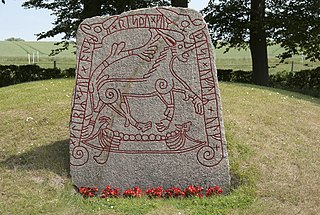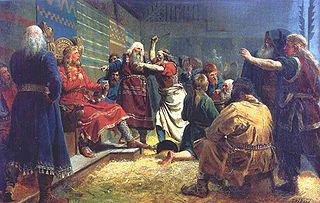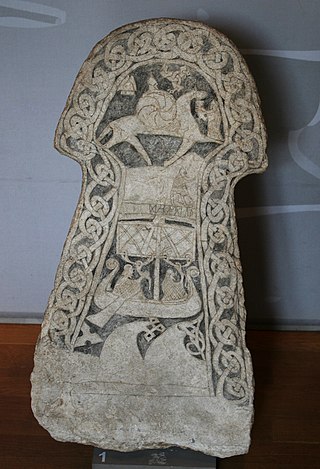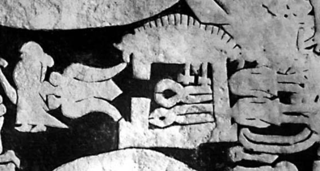Related Research Articles

In Norse cosmology, Álfheimr, also called "Ljósálfheimr", is home of the Light Elves.
Breiðablik is the home of Baldr in Nordic mythology.

Bragi is the skaldic god of poetry in Norse mythology.

Fenrir or Fenrisúlfr, also referred to as Hróðvitnir and Vánagandr, is a wolf in Norse mythology. Fenrir, along with Hel and the World Serpent, is a child of Loki and giantess Angrboða. He is attested in the Poetic Edda, compiled in the 13th century from earlier traditional sources, and the Prose Edda and Heimskringla, written in the 13th century by Snorri Sturluson. In both the Poetic Edda and Prose Edda, Fenrir is the father of the wolves Sköll and Hati Hróðvitnisson, is a son of Loki and is foretold to kill the god Odin during the events of Ragnarök, but will in turn be killed by Odin's son Víðarr.

In Norse mythology Valhalla (;) is the anglicised name for Old Norse: Valhǫll. It is described as a majestic hall located in Asgard and presided over by the god Odin. Half of those who die in combat enter Valhalla, while the other half are chosen by the goddess Freyja to reside in Fólkvangr. The masses of those killed in combat along with various legendary Germanic heroes and kings, live in Valhalla until Ragnarök when they will march out of its many doors to fight in aid of Odin against the jötnar.

Hávamál is presented as a single poem in the Codex Regius, a collection of Old Norse poems from the Viking age. The poem, itself a combination of numerous shorter poems, is largely gnomic, presenting advice for living, proper conduct and wisdom. It is considered an important source of Old Norse philosophy.

Haakon Haraldsson, also Haakon the Good and Haakon Adalsteinfostre, was the king of Norway from 934 to 961. He was noted for his attempts to introduce Christianity into Norway.

In Norse mythology, a valkyrie is one of a host of female figures who guide souls of the dead to the god Odin's hall Valhalla. There, the deceased warriors become einherjar. When the einherjar are not preparing for the events of Ragnarök, the valkyries bear them mead. Valkyries also appear as lovers of heroes and other mortals, where they are sometimes described as the daughters of royalty, sometimes accompanied by ravens and sometimes connected to swans or horses.

In Norse mythology, Göndul is a valkyrie. Göndul is attested in Heimskringla, Sörla þáttr, and a 14th-century Norwegian charm. In addition, Göndul appears within the valkyrie list in the Poetic Edda poem Völuspá, in both of the two Nafnaþulur lists found in the Prose Edda, and among the valkyries listed in Darraðarljóð.

Svalinn is a legendary shield in Nordic mythology which stands in front of Sun, protecting the world from her heat. It has been suggested to be part of a continuous tradition of solar imagery dating back to the Nordic Bronze Age.

In Norse mythology, the einherjar are those who have died in battle and are brought to Valhalla by valkyries. In Valhalla, the einherjar eat their fill of the nightly resurrecting beast Sæhrímnir, and valkyries bring them mead from the udder of the goat Heiðrún. The einherjar prepare daily for the events of Ragnarök, when they will advance for an immense battle at the field of Vígríðr.

Hermóðr is a figure in Norse mythology, a son of the god Odin and brother of Baldr. He is often considered the messenger of the gods.
In Norse mythology, Skögul and Geirskögul are valkyries who alternately appear as separate or individual figures. Both valkyries appear in Heimskringla where they seem to be the same being, and are otherwise listed separately in the valkyrie lists in the Poetic Edda poems Völuspá and Grímnismál, the longer of the two valkyrie lists in Skáldskaparmál yet Skögul appears alone in the shorter of the two. Skögul appears in kennings but Geirskögul does not.
Haakon Sigurdsson, known as Haakon Jarl, was the de facto ruler of Norway from about 975 to 995. Sometimes he is styled as Haakon the Powerful, though the Ágrip and Historia Norwegiæ give the less flattering name Hákon Illi, that is, Haakon the Bad.

Vǫlundarkviða is one of the mythological poems of the Poetic Edda. The title is anglicized in various ways, including Völundarkvitha, Völundarkvidha, Völundarkvida, Volundarkvitha, Volundarkvidha and Volundarkvida.

Eiríksmál is a skaldic poem composed c. 954 at the behest of the Norwegian queen Gunnhild in honour of her slain consort Erik Bloodaxe. Only the beginning of the poem is extant.
Skapti Þóroddsson was an Icelandic lawspeaker and skald. He became lawspeaker in 1004, succeeding his uncle Grímr when the latter's voice failed him. He held office till his death in 1030, longer than anyone else. According to the Íslendingabók he instituted judicial reform by establishing the "fifth court", a national court of appeals.
Glaðr is a horse in Nordic mythology. It is listed as among the horses of the Æsir ridden to Yggdrasil each morning in the Poetic Edda. The Prose Edda specifically refers to it as one of the horses of the Day, along with Skinfaxi.
Völuspá hin skamma is an Old Norse poem which survives as a handful of stanzas in Hyndluljóð, in the Poetic Edda, and as one stanza in the Gylfaginning section of Snorri Sturluson's Prose Edda. The name of the poem is only known due to Snorri's citation of it in Gylfaginning :
References
- ↑ Orchard 1997, p. 71.
Bibliography
- Orchard, Andy (1997). Dictionary of Norse Myth and Legend. Cassell. ISBN 978-0-304-34520-5.